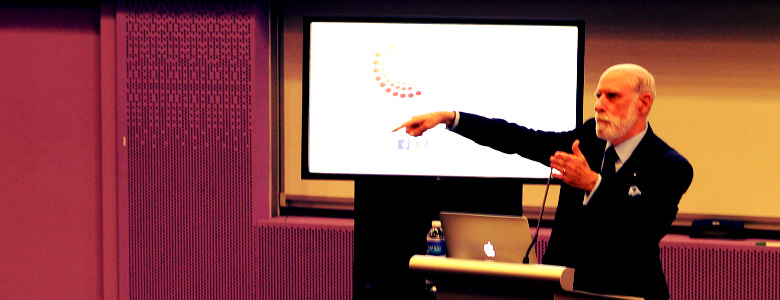From Internet to IoT

Fancy waking up to kaya toast done just right by our smart toaster?
This is just the appetiser in a futuristic world where household devices anticipate our needs and do our bidding.
Thanks to the Internet of Things (IoT) — the network of communications between programmable physical objects such as electrical appliances, light switches and sensors — emergency services could be notified if your elderly parent has a fall, or electricity use in your home could be automatically regulated to save you money, just to name a few possibilities.
But more work needs to done before the IoT can effectively transform the way we live, says 2004 Turing Award winner and ‘father of the internet’ Vinton Gray Cerf.
Dr Cerf was speaking at the Global Young Scientists Summit 2017 (GYSS@one-north 2017), held from 15-20 January 2017 at the Singapore University of Technology and Design.
In 1973, Mr Cerf, working with fellow Turing Award winner Robert Kahn, developed the Transmission Control Protocol and Internet Protocol (TCP/IP), which allowed packets of information to be transmitted in a controlled manner between computers on different networks.
These communication protocols now form the basis of the modern-day internet. The pair subsequently received the US Presidential Medal of Freedom in 2005, the country’s highest civilian award, for their pioneering work.
Cool idea to protect hot data
In his role as Google’s Vice President and ‘Chief Internet Evangelist’, Dr Cerf works to help more people around the world gain access to the internet.
But he has also done a lot of thinking about how best to design and implement the IoT.
Ensuring that the IoT is safe to use is a top priority, said Dr Cerf. Building safeguards around data collected by IoT devices—even information as mundane as temperature readings—is critical.
Such information may seem innocuous, but could be dangerous in the wrong hands, he said.
“If you have six months’ worth of temperature data, you may be able to figure out how many people are in the house, which rooms they are in, or what their diurnal patterns are. You might be able to figure out when the house is likely to be empty—and if you happen to be somebody who wants to rob the house, that’s useful data,” cautioned Dr Cerf.
“Even humble temperature data, collected over a long period of time, can be abused.”
Consumers are rightly concerned about safety and privacy, said Dr Cerf, and the industry needs to find ways to show the public that appropriate checks have been done. In the US, he noted, electrical appliances, cars and other products are tested and certified safe by organisations such as Underwriters Laboratories (a safety consulting company).
Something similar, he thinks, could be put in place for software.
“We need a kind of cyber Underwriters Laboratories that will look at code,” he said, adding that such efforts are already getting started.
Artificial idiocy?
Developments in machine learning and artificial intelligence (AI) will allow for more finely-tuned control over IoT devices, said Dr Cerf.
Homeowners may on occasion need to grant certain parties access to IoT data—in an emergency, for example, a truly smart system could grant the fire department access to temperature sensors, so that rescuers can pinpoint the centre of the inferno, as well as to security cameras, so that they can find people trapped in the building.
Once the emergency is over, the system will also need to be able to revoke this access.
Ideally, such a system would also be able to differentiate between house guests and would-be robbers, as well as between parents and children, and restrict access accordingly, he said.
But for all the promise of AI, it still has quite a way to go, said Cerf, citing the example of how Microsoft’s chatbot ended up being trained by Twitter users to make racist remarks.
“My experience is that we create artificial idiots,” he quipped.
Helping IoT devices to talk together
New products with IoT capabilities—from digital picture frames to coffee machines you can control from your phone—are constantly appearing on the market.
But these tend to run on disparate pieces of software that don’t play well with each other.
“Everybody is going in whatever direction they think is best—they’re all pushing to get products out the door,” said Dr Cerf. “So you have this splattering of standards and protocols, none of which are even necessarily working.”
Given that the houses, offices and factories of the future could contain hundreds or even thousands of IoT devices, having to control each one from a different app is completely unfeasible. In order to truly integrate these devices into one cohesive network, developers need to settle on a set of standards.
“We need some serious work in the standards space,” added Dr Cerf. “We don’t want to prematurely standardise—we want to standardise things that we know will work. The next decade or so is going to be a messy period.”
But combing through this mess will be worth it—with interoperability, devices could be put to work in new and innovative ways.
“Imagine that you’re not the maker of any of the devices, but you know that they can interwork. You could think up new ways to use these collections to do something useful for your customers,” said Dr Cerf.
“Ensembles of devices from multiple manufacturers, working together, can be a really powerful way of igniting new ideas.”
It sounds like in the future of IoT, we can definitely have our kaya toast and eat it too!
https://www.tech.gov.sg/media/technews/from-internet-to-iot
